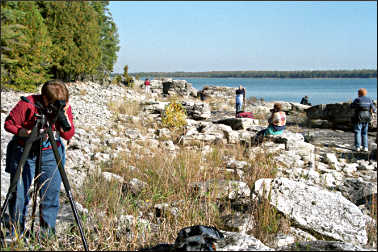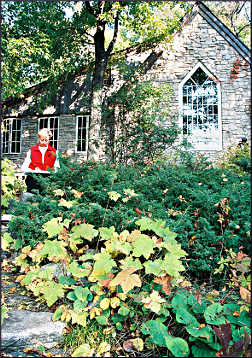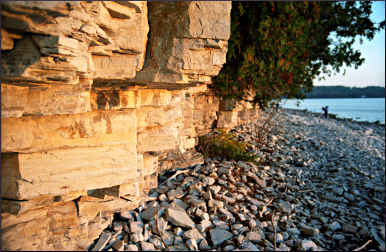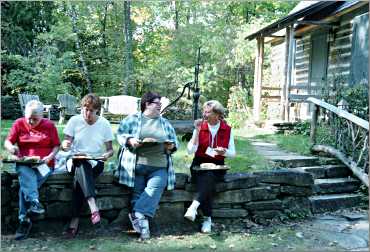Classroom in the Clearing
In a tranquil Door County forest, students gather to reflect and learn.

© Beth Gauper
In a cedar and pine forest on Lake Michigan, moments of illumination fly around like sparks off a campfire.
The best way to capture sunrise on film. Handy techniques for depicting shadow in watercolors. How to harness the power of the inner eye.
At the Clearing in Door County, everything becomes clearer.
In the 1920s and '30s, a Danish landscape architect from Chicago was toiling around the Midwest, beautifying the estates of the Armours, the Fords, the Florsheims.
But his thoughts were on a landscape to the north, where he had bought blufftop land at the top of the Door Peninsula, with a view of Lake Michigan's Green Bay and the setting sun.
Jens Jensen wanted to build a folk school in the Scandinavian tradition, a place where ordinary people could escape the city to learn and relax in a beautiful setting.
"Every one is entitled to a home where the sun, the stars, open fields, giant trees and smiling flowers are free to teach an undisturbed lesson of Life," he wrote.
He was still hauling limestone for the school's buildings into his 80s, and after he died, his work was carried on by his associate, Mertha Fulkerson, and then by the Friends of the Clearing.
Today, more than a thousand people every year come to the Clearing to polish skills and perceptions — in writing, music, natural sciences, philosophy, wood carving, quilting, yoga, gardening.
They stay in cottages made from stone quarried from the land and sleep under quilts stitched by students. They eat home-baked breads and walk paths lined by Arts and Crafts lanterns designed by Clearing staff and made by volunteers.
They paint, write and study in a sunlit 1938 schoolhouse wrapped by stone buttresses and ivy.
In the stone lodge, they gather around a clerestory window with a view of the bay and three white pines, under portraits of a white-haired pixie who firmly believed in the power of nature to renew weary souls.

© Beth Gauper
"He guides a lot of our thoughts here," said director Mike Schneider. "Our standards are high because Jensen's standards were high; we're just carrying them through.
"It's funny, because he's been dead 50 years, but we find ourselves, when building buildings or buying furniture, thinking, 'Would Jens approve?' "
Jensen's vision seemed particularly inspired on a week in mid-October, when the Door Peninsula was aglow in autumn colors.
At the Clearing, aspen formed a golden canopy over the narrow drive leading toward the campus, and scarlet ivy wound over white stone buildings bathed in sun.
Watercolor painters and nature photographers converged on the Clearing that week. I was among 13 people studying with Chicago-area photographer Hank Erdmann, who was teaching "The Art of Nature and Outdoor Photography."
Eighteen students had signed up for Green Bay artist Bridget Austin's extremely popular watercolor class, and all had snared their spots by calling in the first hour after registration opened in February.
"This is my 13th year in a row, mostly watercolor, and needless to say, I look forward to it all year," said Chris Sommerfelt of Wauwatosa, Wis., at the orientation.
Many of the students spoke reverently of Austin, a pleasant woman who tosses off exquisite sketches with relaxed deftness. "We have an incredible teacher," said Ronna Rawlins of Beaver Dam, Wis. "She tells jokes while she's demonstrating, and she'll make a work of art."
As the painters worked away in the airy, sunlit schoolhouse, the photographers struggled with f-stops, apertures, hyperfocal distance and exposure control.
The camera, Erdmann explained, wants to move brights and darks toward midtones. So to stop a field of blindingly white snow from becoming gray, a photographer has to add light to the bright scene, knowing that the camera is subtracting it.
To keep the detail in the dark bark of a tree, she has to take away light, knowing that the camera is adding it.
For many students, it was an a-ha! moment. We sat mutely, mulling it over.
"I think I've been doing the opposite," Teri Czarnecki of Slinger, Wis., finally said.
"That explains a lot," said Nita Herreman of Wilmette, Ill..
The more subtle demands of composition seemed easier to understand — until we got back our slides, which Clearing staff had driven all the way to Green Bay to have developed. Then we realized that what the camera saw had been different from what our eyes saw.
The images we thought were going to be so beautiful had slanting horizons, subjects that blended into backgrounds and fuzzy weeds poking into our frames.
After that, we had a lot of questions.

© Beth Gauper
First, Erdmann told us, we have to train ourselves to actually see what's in our viewfinder. Then, we have to make the camera — a blank slate — interpret what our eyes see.
"The eye sees a lot more than a camera, because the eye is connected to a brain," Erdmann said. "If I can get you to do anything this week it's to see differently, to see objectively. Then I've done my job."
Erdmann even went beyond the call of duty, heaping us with illustrated booklets he'd made himself, taking us on field trips every day and giving one slide lecture after another.
"I told Hank I think I've regressed," joked Hermi Krueger of Appleton, Wis. "I'm so overloaded with information I don't know anything."
But our hard work was punctuated by superb meals, served at trestle tables in the lodge. As we sat at dinner one day, gazing at the dessert set before us — freshly baked cherry cobbler with vanilla ice cream — Herreman sighed and said, "Life is going to be hard next week."
As Jens Jensen knew, life in the city and suburbs is different from life on the Door Peninsula. The Door is lovelier — and, north of the busy tourist towns of Fish Creek, Ephraim and Sister Bay, much more serene.
On our sunrise excursions to Europe Bay beach and Cave Point County Park, and field trips to Toft Point Natural Area and into the countryside, we marveled at our luck in being there.
And sprawled on cliffs and in fields, zeroing in on our photo subjects — a picturesque milkweed pod, a patch of herb rocket, a puddle turned pink by the rising sun — we probably were as "close to the soil" as Jensen had wanted us to be.
At the end of the week, everyone assembled for songs, skits and a show of paintings and photos.
Amid their joking and laughing, the painters had compiled an amazing oeuvre. Judy Larson of Greendale, Wis., had finished eight pieces, including a red barn with a foreground of wildflowers that, I told her, looked exactly like a scene my class would have loved to shoot.
"We're like photographers, we're always looking," Larson said. "This tree, that stump — there's so much to look for."
I know I'll think of Erdmann and the class whenever I "garden" for a close-up — that is, brush aside stray vegetation that would have cluttered the edge of my frame.

© Beth Gauper
Perhaps, as he hoped, I've learned to see. Over breakfast on the last day, Nita Herreman said that's what she hopes, too.
"I wanted to break out of the box," she said. "I needed new perspectives. And I think I got that."
Trip Tips: The Clearing
Getting there: Ellison Bay is in the northern Door, about an hour and a half from Green Bay.
Classes: The May-October season includes dozens of classes on nature, writing, music, philosophy and arts.
Registration: In December, the Clearing puts out a flier that lists class titles, dates and fees. The catalog comes out late January or early February, and registration is held in mid-February.
Students can register online. Some of the classes — watercolor painting, oil painting and quilting in particular — fill in the first hour they're available.
Information: The Clearing, 877-854-3225.